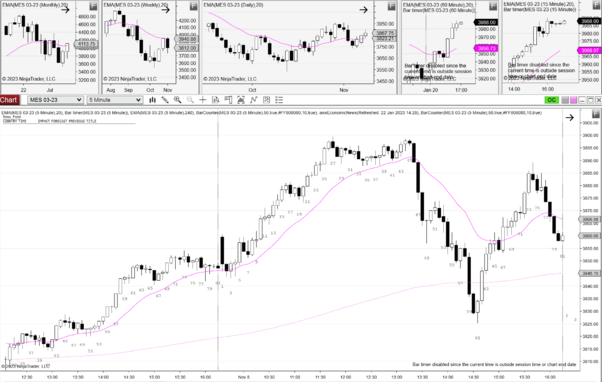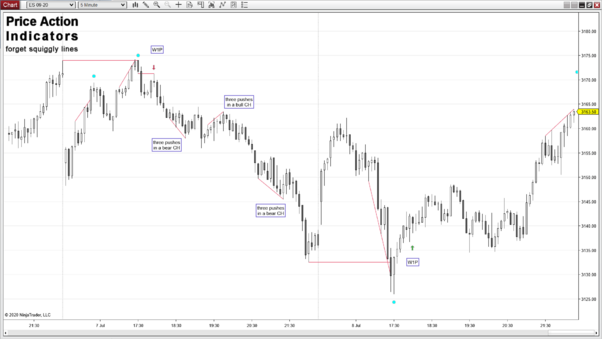Category:W1P:修订间差异
无编辑摘要 |
(恢复为纯英文,中文moved to "中文" tab) |
||
| (未显示2个用户的7个中间版本) | |||
| 第1行: | 第1行: | ||
<abbr>''The 1st pullback after the reversal attempt from a wedge bottom.''</abbr> | |||
== General == | == General == | ||
[[File:Wedges 6.png|thumb|602x602px]]<abbr>'' | [[File:Wedges 6.png|thumb|602x602px]]<abbr>''Among many different variations of MTR, especially [[HLMTR]] and [[LHMTR]], there are certain type of setups that have higher chance of success, based on various factors. [https://www.priceactionindicators.com/about/ Thomas Deutschmann] had a post [https://www.priceactionindicators.com/2020/07/29/trade-the-1st-pullback-after-a-wedge-the-w1p/ Trade the 1st Pullback after a Wedge – the W1P!] that explained a concept called W1P that was originally brought up by [https://ninetrans.blogspot.com/2011/02/wedge-reversals-and-w1p.html cadaver]. W1P is actually a special case of HLMTR/LHMTRs that cadaver narrowed it down with some specific criterias so that '''trader can use them to find the best MTR set up, and avoid less-good set ups'''.''</abbr> <abbr>''More example chart can be found here:''</abbr> ''https://www.priceactionindicators.com/2020/07/29/trade-the-1st-pullback-after-a-wedge-the-w1p/. (Credit to Thomas Deutschmann)'' | ||
[[File:20221108pa.png|thumb|602x602px|Figure 1 - [[20221108]]]] | [[File:20221108pa.png|thumb|602x602px|Figure 1 - [[20221108]]]] | ||
'' | == Wedge reversal == | ||
''A Wedge reversal (three or four pushes each with a new extreme) forming at the top or bottom of a trend is probably the most successful setup for a swing trade.'' | |||
# ''Strong reversal bar (with an average size), that isn’t | === Most crucial === | ||
# ''Strong entry bar (closed around its high), preferably larger than the reversal bar, for e.g. bar 62 in figure 1.'' | ''A clear trend <abbr>channel</abbr> line overshoot and in particular a second overshoot, which essentially makes it a typical [[PW]]. It is actually better if the wedge is more climactic than being a "weaker" wedge. By a "weaker" wedge, traders can feel a sense of lacking strength or urgency of both buying and selling. For e.g. on [[20230508]], the wedge 5-9-13 is a "weaker" form of wedge.'' | ||
=== Strengtheners === | |||
''The more strengtheners the higher probability of success.'' | |||
# '''''Strong reversal bar''' (with an average size), that isn’t overlapping with prior swing low, i.e. the 3rd or 4th push created a clear gap below the prior low, see the gap below 57L and 61H in figure 1.'' | |||
# '''''Strong entry bar''' (closed around its high), preferably larger than the reversal bar, for e.g. bar 62 in figure 1.'' | |||
# ''The <abbr>pullback (if any) after the entry bar</abbr> '''should not take out the <abbr>entry bar</abbr> by more than''' '''one tick'''.'' | |||
# ''One push move off the wedge <abbr>signal bar</abbr>, that takes out a prior swing point, indicating bulls ability to close the gap quickly, hence strong [[BP]].'' | # ''One push move off the wedge <abbr>signal bar</abbr>, that takes out a prior swing point, indicating bulls ability to close the gap quickly, hence strong [[BP]].'' | ||
# ''Breakout test of the entry price of the reversal bar during the <abbr>[[W1P]](1st pullback after the Wedge).</abbr> | # ''Breakout test of the entry price of the reversal bar during the <abbr>[[W1P]](1st pullback after the Wedge).</abbr> In figure 1, the W1P happened at bar 67 but was bought quickly and never get close to bar 62 the entry bar.'' | ||
# | |||
=== Weakeners === | |||
# ''Overshoot is small (a tick or two) and there is only one overshoot'' | |||
# ''There is an overshoot but it does not look like extreme behavior (W are extreme behaviors)'' | |||
# ''The reversal signal and entry bars are weak'' | |||
''The above signs of weakness may imply trend termination into trading range or simply a pullback<ref>[http://ninetrans.blogspot.com/2011/01/four-trades-off-nine-transitions.html ''http://ninetrans.blogspot.com/2011/01/four-trades-off-nine-transitions.html'']</ref>.'' | |||
'' | == ''Stop order entry'' == | ||
* ''buy above the W1P bar using.'' | |||
* ''or buy above the bull reversal bar, higher RR but lower probability.'' | |||
== ''Stop Placement'' == | == ''Stop Placement'' == | ||
''Either use a bar stop below the <abbr>W1P</abbr> bar, or for a higher probability trade (but lower reward/risk) use a stop beyond the wedge reversal signal (bar 61 in above example).'' | ''Either use a bar stop below the <abbr>W1P</abbr> bar, or for a higher probability trade (but lower reward/risk) use a stop beyond the wedge reversal signal (bar 61 in above example).'' | ||
<references /> | |||
[[Category:MTR]] | |||
[[分类:GOOD SWING CHOICES]] | |||
2024年2月5日 (一) 17:12的最新版本
The 1st pullback after the reversal attempt from a wedge bottom.
General[编辑 | 编辑源代码]
Among many different variations of MTR, especially HLMTR and LHMTR, there are certain type of setups that have higher chance of success, based on various factors. Thomas Deutschmann had a post Trade the 1st Pullback after a Wedge – the W1P! that explained a concept called W1P that was originally brought up by cadaver. W1P is actually a special case of HLMTR/LHMTRs that cadaver narrowed it down with some specific criterias so that trader can use them to find the best MTR set up, and avoid less-good set ups. More example chart can be found here: https://www.priceactionindicators.com/2020/07/29/trade-the-1st-pullback-after-a-wedge-the-w1p/. (Credit to Thomas Deutschmann)

Wedge reversal[编辑 | 编辑源代码]
A Wedge reversal (three or four pushes each with a new extreme) forming at the top or bottom of a trend is probably the most successful setup for a swing trade.
Most crucial[编辑 | 编辑源代码]
A clear trend channel line overshoot and in particular a second overshoot, which essentially makes it a typical PW. It is actually better if the wedge is more climactic than being a "weaker" wedge. By a "weaker" wedge, traders can feel a sense of lacking strength or urgency of both buying and selling. For e.g. on 20230508, the wedge 5-9-13 is a "weaker" form of wedge.
Strengtheners[编辑 | 编辑源代码]
The more strengtheners the higher probability of success.
- Strong reversal bar (with an average size), that isn’t overlapping with prior swing low, i.e. the 3rd or 4th push created a clear gap below the prior low, see the gap below 57L and 61H in figure 1.
- Strong entry bar (closed around its high), preferably larger than the reversal bar, for e.g. bar 62 in figure 1.
- The pullback (if any) after the entry bar should not take out the entry bar by more than one tick.
- One push move off the wedge signal bar, that takes out a prior swing point, indicating bulls ability to close the gap quickly, hence strong BP.
- Breakout test of the entry price of the reversal bar during the W1P(1st pullback after the Wedge). In figure 1, the W1P happened at bar 67 but was bought quickly and never get close to bar 62 the entry bar.
Weakeners[编辑 | 编辑源代码]
- Overshoot is small (a tick or two) and there is only one overshoot
- There is an overshoot but it does not look like extreme behavior (W are extreme behaviors)
- The reversal signal and entry bars are weak
The above signs of weakness may imply trend termination into trading range or simply a pullback[1].
Stop order entry[编辑 | 编辑源代码]
- buy above the W1P bar using.
- or buy above the bull reversal bar, higher RR but lower probability.
Stop Placement[编辑 | 编辑源代码]
Either use a bar stop below the W1P bar, or for a higher probability trade (but lower reward/risk) use a stop beyond the wedge reversal signal (bar 61 in above example).

